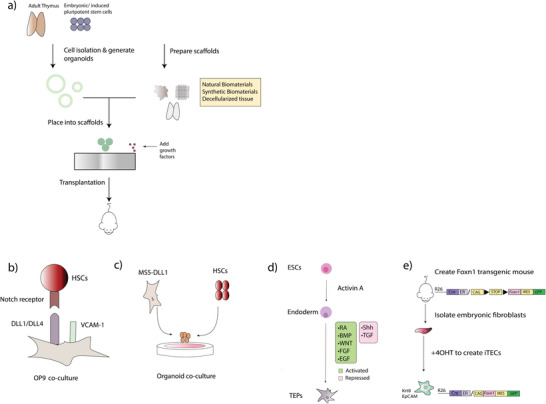Figure 4.

Regenerative approaches of the thymus. a) Illustration of the approaches to generate organoids using scaffolds. Briefly, TECs are extracted either from primary/embryonic tissue or created from ESCs/iPSC. Thereafter, they are expanded in scaffolds made from either natural polymer, synthetic materials, or decellularized tissues, which can be transplanted. b) OPDL1 culture system. OP9 cells are induced to express DLL1/4 (virally or synthetically), which differentiates HSCs into the T cell lineage. VCAM‐1 can be added to OP9 cultures, which acts synergistically with DLL4 to enhance T cell differentiation in a serum free culture. c) MS5‐DLL1 cells can be centrifuged and aggregated with HSCs to make organoids in a 3D co‐culture system. d) ESC‐derived TECs. ESCs are first subjected to Activin A to induce the formation of the definitive endoderm. Subsequently, various signaling pathways are modulated to develop TEPs. e) Reprogramming cells into TECs. Briefly, FOXN1 was knocked into a Rosa26 locus. Crossing them with Rosa26 CRERT2 mice yielded Rosa26CreERt2/CAG−STOP−FOXN1−IRES−GFP mice. Fibroblasts were isolated from embryos that were induced to overexpress FOXN1 upon the administration of tamoxifen (40HT), which reprogrammed them into TEC like cells with the expression of Krt8+ and EpCAM (termed iTECs). Other studies have augmented FOXN1 in mice as a treatment for a deteriorated thymus as seen in ref. [89].
